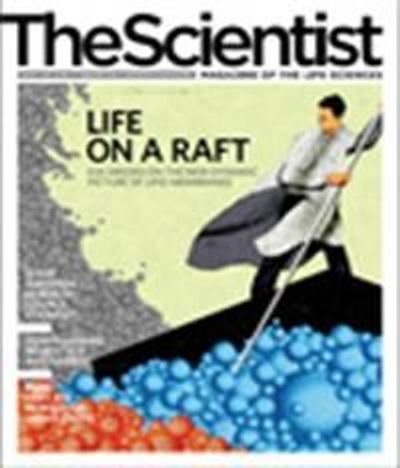Lit Lazarus worms

© Sinclair Stammers / Photo Researchers, Inc.
When postdoc Usama Al-Atar returned to retrieve his worms after an hour of incubating them with a photo-controlled molecular switch, he thought they were dead. Dozens of nematodes hung lifeless in solution, and Al-Atar could not see the rhythmic beating of their tiny pharyngeal bulbs (worm hearts) with his low magnification microscope. But when he exposed them to visible light—which was known to change the switch, a synthetic photoreactive molecule called bis(pyridinium) dithienylethene (DTE) 1, from its closed to its open form—he saw the worms start to stir.
“I saw one worm moving and then a second worm started moving,” Al-Atar says. “They came back alive.” He quickly turned on the video camera and started recording the miracle. When he shared the results with his advisor, Neil Branda of Simon Fraser University in British Columbia,...
“I, as the ultimate skeptic, said, ‘Well that’s crazy—what makes you think they’re going to do that?’” Branda recalls. But after seeing the video, “I was of course convinced that this was working.” Al-Atar was using UV light to convert DTE to its open form and reversing the paralysis caused by the closed form of the molecule. The closed form of DTE is a better electron acceptor than the open form and may be interfering with the electron transport system, possibly acting as a “circuit breaker” in the cells’ energy production pathway, thereby causing paralysis. (Later experiments using a higher-magnification microscope confirmed that the worms’ hearts were indeed beating all along.)
“We’re not going to pretend that the function of paralysis is going to have a future application,” Branda says, but this is “proof of principle showing that you can turn on and off biological functions using photoswitches.”
What’s novel about this study, Branda adds, is the fact that the effect of the photoswitch was reversible. While visible light converted the molecule from closed to open, UV light did just the opposite. “It’s the first example of that [type of photoswitch] being used in vivo,” says Andrew Woolley of the University of Toronto, who studies peptides and proteins that can be altered with light.
Unlike protein switches, “you can generally make chemical modifications to the structure of the [chemical] switch that will have fairly predictable effects. The designability is very appealing,” Woolley says.
Branda is optimistic that these types of switches will one day be applicable in clinical contexts, such as the photocontrol of enediynes—a class of natural compounds that are being studied for use as antitumor agents. The problem with enediynes is their lack of selectivity. “They’re too potent,” Branda says. “They’re killing everything.”
In 2007, Branda developed a system to control the activation of enediynes (Angew Chem Int Ed, 46:8017–19, 2007). Similar to Al-Atar’s experiment with the worms, Branda and his colleagues used UV and visible light to open and close the ring structure of a DTE. By integrating DTE and enediyne molecules, Branda was able to manipulate the enediynes structure, converting it between an inactive and active form.
However, to acquire its toxic, cancer-killing capabilities, the “active” form of the enediyne needed to undergo one more step: a heat-driven conversion that requires temperatures far too high to take place safely within the body. Furthermore, these experiments were carried out in benzene, unlike the worm studies, which used water-soluble compounds. “We’re looking now at coming up with other ways of getting photoswitches to work in water and at a lower temperature,” Branda says.
Another problem Branda hopes to tackle is using lower-energy light to initiate these reactions. The high-energy UV light used in the worm experiment cannot penetrate most human tissues and is potentially harmful. Low-energy types of light, such as near infrared (NIR), can go deeper into the body while doing less damage, he says.
To this end, Branda exploited a type of nanoparticle as a sort of “remote control” for a DTE photoswitch (J Am Chem Soc, 131:10838–39, 2009). These so-called “photon upconverting nanoparticles” efficiently absorb NIR light and “up-convert” it to the wavelengths required to activate the DTE switch. “That’s the real trick, so you can generate the light inside the body,” Branda says.
Interested in reading more?

